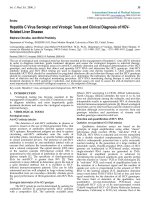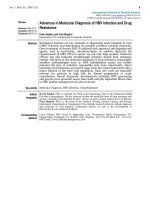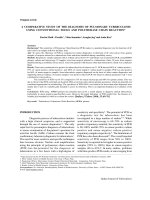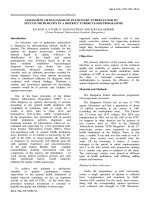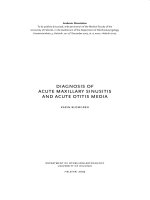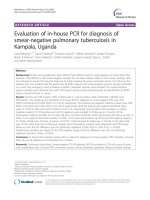Acoustic diagnosis of aortic stenosis
Bạn đang xem bản rút gọn của tài liệu. Xem và tải ngay bản đầy đủ của tài liệu tại đây (324.47 KB, 13 trang )
ACOUSTIC DIAGNOSIS OF AORTIC STENOSIS
SUN ZHANYU
(B. Eng., Zhejiang University)
A THESIS SUBMITTED FOR
THE DEGREE OF MASTER OF ENGINEERING
DEPARTMENT OF MECHANICAL ENGINEERING
NATIONAL UNIVERSITY OF SINGAPORE
2004
Acknowledgements
ACKNOWLEDGEMENTS
This study was supported with the grant from Singapore National Healthcare Group.
My first appreciation must be given to my supervisor Dr. Chew Chye Heng, for his
seasoned guidance. It is him who offered me this opportunity and opened a new window
in my academic life. The author would like to express his sincere gratitude to Dr. Hong
Geok Soon and Dr. Lim Kian Meng, who provided precious suggestions during this
project.
I would like to express my sincere gratitude to Dr. Poh Kian Keong and Dr. Mark Chan,
who established the patient group and provided the medical records of the patients.
I want to thank the FYP students – Boo Kun Ming, Teng Seok Po, Liew Shuhui, Loh
Teck Kam, and Tan Chee Keong, who helped to produce the wavelet and peak plots. I
would like to thank Mr Cheng, the technician for this project, for his participation in
collecting the data from the hospital. The author appreciates the help rendered by the
technicians in Dynamics Lab - Ahmad, Amy, and Priscilla.
Finally I would like to send my gratitude to my parents for their constant encouragement
and support.
i
Table of Contents
TABLE OF CONTENTS
ACKNOWLEDGEMENTS
i
TABLE OF CONTENTS
ii
SUMMARY
v
LIST OF TABLES
vii
LIST OF FIGURES
viii
LIST OF SYMBOLS
x
LIST OF ABBREVIATIONS
xii
CHAPTER 1: INTRODUCTION
1
1.1 Objective 1
1.2 The Cardiac Anatomy & The Cardiac Cycle 1
1.3 Origin of the Phonocardiogram & the Areas of Auscultation 3
1.4 The Dynamics of the AS 7
1.5 Literature Review on the Acoustic Diagnosis of AS 11
CHAPTER 2: TIME-FREQUENCY REPRESENTATIONS
14
2.1 The Fast Fourier Transform 14
2.2 The Short-Time Fourier Transform 15
2.3 Various Bilinear Distributions 18
2.4 The Continuous Wavelet Transform 20
2.5 Comparison of the Performance of Various Time-Frequency Methods
on Phonocardiogram
22
ii
Table of Contents
CHAPTER 3: METHODOLOGY
25
3.1 Instrumentation & The Subject Groups 25
3.2 The Normalized Continuous Wavelet Transform 27
3.3 A Multi-Peak Detection Algorithm 29
3.4 The First Indicator of the Severity of the AS – The Dominant
Frequency of the Systolic Murmurs
37
3.5 The Second Indicator of the Severity of the AS – The Spectral Ratio
of the Systolic Murmurs
39
3.6 The Third Indicator of the Severity of the AS – The Integration of the
Normalized Continuous Wavelet Transform of the Systolic Murmurs
41
3.7 The Fourth Indicator of the Severity of the AS – Combination of the
Systolic Murmurs and the Second Heart Sound
42
CHAPTER 4: RESULTS & DISCUSSION
44
4.1 The Influence of the Breath Noise on the Systolic Phonocardiogram 44
4.2 The Dominant Frequency of the Systolic Murmurs 49
4.3 The Spectral Ratio of the Systolic Murmurs 52
4.4 The Integration of the Normalized Continuous Wavelet Transform of
the Systolic Murmurs
60
4.5 Combination of the Systolic Murmurs and the Second Heart Sound 61
4.6 Hemodynamic Correlation 61
4.7 Clinical Application 63
4.8 Comparison with Previous Studies 67
iii
Table of Contents
CHAPTER 5: CONCLUSION
70
CHAPTER 6: RECOMMENDATIONS
72
BIBLIOGRAPHY
73
iv
Summary
SUMMARY
The objective of this study is to develop a noninvasive diagnostic tool to objectively
assess the severity of the aortic stenosis (AS). Specifically, the phonocardiogram (PCG)
signal is measured on the chest wall and processed to extract the information to be used in
the estimation of the severity of the AS.
A novel multi-peak detection algorithm is developed. This multi-peak detection algorithm
is of key importance in the signal processing of this study. With this multi-peak detection
algorithm, the peak distribution of the normalized continuous wavelet transform (NCWT)
is generated. This multi-peak detection algorithm is also used to detect the R-, T-, P-
waves of the ECG signal, which help in the localization of the systolic PCG signal.
The influence of the breath noise on the systolic PCG signal is studied. It is found that the
breath noise mainly contaminates the frequency content below 60Hz. Also the systolic
PCG signal in the normal breath condition shows better consistency – less cycle-to-cycle
variation in the spectral content than that in the holding breath condition. Therefore, the
normal breath condition is more advantageous than the holding breath condition in the
acoustic diagnosis of the AS.
In the assessment of the severity of the AS, four indicators are developed: 1) the dominant
frequency (DF) of the systolic murmurs (SM); 2) the spectral ratio (SR) of the SM; 3) the
integration of the NCWT of the SM (
); and 4) the combination of the SM and the
SI
v
Summary
second heart sound ( ), respectively. These four indicators are then correlated
with the hemodynamic parameters obtained with echocardiography. The DF correlates
best with the hemodynamic parameters: r = 0.63 with the maximal velocity of blood flow
through aortic valve (AVMAX), r = 0.57 with the mean transaortic pressure gradient
(AMPG), r = -0.72 with the aortic valve area calculated using continuity equation
(AVAC), and r = 0.69 with the ratio
2/ SSM
AVACAVMAX /. The
SI
correlates well with the
hemodynamics parameters: r = 0.52 with AVMAX, r = 0.48 with the AMPG, r = -0.60
with AVAC, and r = 0.56 with
AVACAVMAX / . No meaningful correlations are found
on the SR and the
. The correlation result suggests that the DF and the
SI
are
able to reflect the AVAC and the AVMAX, while less competent to tell the AMPG. With
these four indicators, the 64 subjects under study with or without the AS of various
severities are classified into three groups – severe AS, moderate AS, and other conditions.
Two methods are employed in the acoustic classification. An agreement rate with the
echo classification of 78% is achieved by both methods. It is suggested that although the
acoustic diagnostic method developed in this study cannot accurately predict the severity
of the AS, it is useful to perform the screening classification before the use of any
invasive method.
2/ SSM
vi
List of Tables
LIST OF TABLES
Chapter 4
Table 1 The Spectral Ratios of the Young Volunteers with Different Cutoff
Frequencies Ranging From 25-150 Hz
45
Table 2 The Variation of the Spectral Ratios of 8 Cardiac Cycles in Normal
and Holding Breath Conditions
47
Table 3 The Hemodynamic, Acoustic Data and Particulars of the First
Subject Group
50
Table 4 Correlation of the DF of the SM with the Hemodynamic Data and
the Linear Regression Result
55
Table 5
Correlation of the
with the Hemodynamic Data and the Linear
SI
Regression Result
60
vii
List of Figures
LIST OF FIGURES
Chapter 1
Fig. 1.1 Chambers and Valves of the Heart
2
Fig. 1.2
Dynamics of a Cardiac Cycle 4
Fig. 1.3
Best Auscultation Areas of Various Murmurs 6
Fig. 1.4
The Anatomy of AS 7
Fig. 1.5
Turbulent Velocity Signal From the Ascending Aorta of a Patient with AS 8
Fig. 1.6
Schematic Diagram Showing Flow Regions Produced by a Stenosed AV 9
Chapter 2
Fig. 2.1 The Trade-off Between Time and Frequency Resolutions in STFT with
Rectangular Window Function
17
Fig. 2.2 The WD of a Signal Composed of Two Chirps with Linearly Rising
Frequency
19
Fig. 2.3 The Time and Frequency Resolutions of (a) STFT and (b) CWT 20
Fig. 2.4 The Envelope of the Coefficient Distributions of (a) Morlet Wavelet and
(b) Mexican Hat with the Same Central Frequency at 50 rad/s
22
Fig. 2.5 Recognizing the Aortic Component and the Pulmonary Component of the
Second Heart Sound
23
Chapter 3
Fig. 3.1 The Recording of the Simultaneous ECG and PCG Signals of a Patient
with Severe AS
26
Fig. 3.2 (a) NCWT and (b) CWT of a Chirp Signal of Constant Amplitude with
Linearly Rising Frequency From 20Hz to 220Hz
28
Fig. 3.3 Multi-Peak Detection Algorithm 31
viii
List of Figures
Fig. 3.4 Peak Detection Results of a NCWT Plot 35
Fig. 3.5 An Example of the Characteristic ECG Waves Recognition 37
Fig. 3.6 Selecting the SM Template 39
Fig. 3.7 The Spectrum of the SM of a Patient With Severe AS 40
Chapter 4
Fig. 4.1 The SR (with cutoff frequency at 60Hz) of the Systolic PCG signals of the
Young Male Volunteers with Normal Breath (green line) and Holding
Breath (blue line)
46
Fig. 4.2 The NCWT Plots of the PCG signals of BR6 48
Fig. 4.3 The NCWT Plots of the SM recorded at the Aortic Area of Some Subjects
without or with AS of Different Severities
53
Fig. 4.4 The DF of the SM Vs the Hemodynamic Data 56
Fig. 4.5
The
Vs the Hemodynamic Data
SI
58
Fig. 4.6 Guidelines of the 4 Indicators for the classification of the Severity of the
AS
65
ix
List of Symbols
LIST OF SYMBOLS
a
Scale factor
b
Time translation factor
c
NCWT coefficient
),(
ω
tC
General bilinear distribution
2A
C
Maximum coefficient of the NCWT of the A2
d Diameter of the aortic valve orifice
D Diameter of the sclerosis
EH
Energy of the high-frequency band
E
L
Energy of the low-frequency band
f
Frequency
b
f
Bandwidth parameter of Morlet wavelet
c
f
Center frequency of Morlet wavelet
s
f
Sampling Frequency
2A
f
Frequency of
2A
C
)(
ω
F
Spectrum
),(
ξ
bsG
w
STFT distribution
n
Index of the discrete time-domain signal
),( absNW
ψ
NCWT distribution
t
Time
)(ts
Time-domain signal
x
List of Symbols
U Jet velocity
V Mean velocity of the blood flow in the unobstructed portion of the artery
)(tw
Window Function
),(
ω
tW
WVD distribution
),( absW
ψ
CWT distribution
ξ
Frequency translation factor
ω
Angular frequency
τ
Time translation factor
θ
Frequency translation factor
κ
Threshold factor in R-wave detection
η
Threshold factor in step 2 of the multi-peak detection
µ
Threshold factor in step 3 of the multi-peak detection
)(x
ψ
Mexican Hat wavelet
ψ
Conjugate of the analyzing wavelet
),(
τ
θ
φ
Kernel function
f∆
Frequency resolution
t∆
Time resolution
T∆
Systolic murmurs’ duration
xi
List of Abbreviations
xii
LIST OF ABBREVIATIONS
A2 Aortic Component of the Second Heart Sound
AMPG The Mean Transaortic Pressure Gradient
AS
Aortic Stenosis
AV Aortic Valve
AVAC The Aortic Valve Area Calculated Using Continuity Equation
AVMAX The Maximal Velocity of The Blood Flow Through The Aortic Valve
CWT Continuous Wavelet Transform
DF Dominant Frequency
ECG
Electrocardiogram
FFT Fast Fourier Transform
NCWT Normalized Continuous Wavelet Transform
P2 Pulmonary Component of the Second Heart Sound
PCG Phonocardiogram
S2 Second Heart Sound
SI The Integration of the Continuous Wavelet Distribution of the SM
SM Systolic Murmur
SM/S2 The Combined Information of SM and S2
SR Spectral Ratio
STFT Short Time Fourier Transform
WD Wigner Distribution
